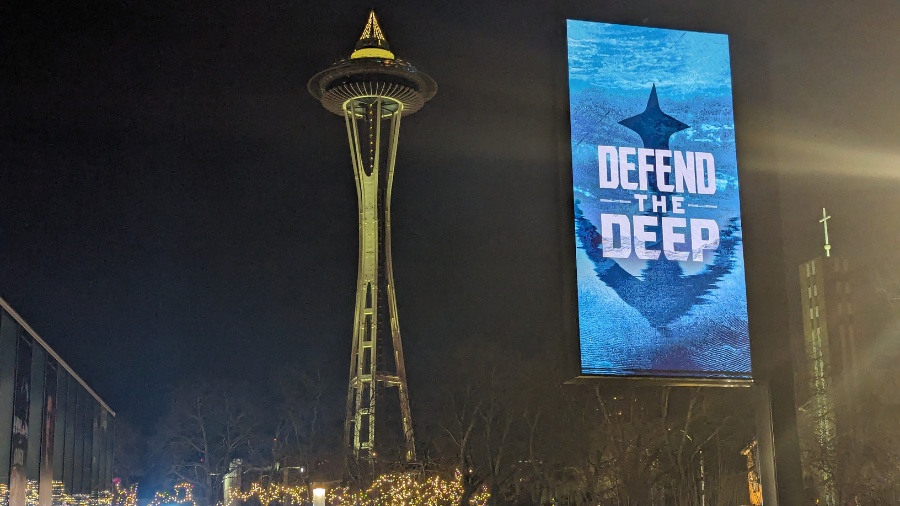As ‘Big Dark’ fades in Washington, daylight saving time debate goes on
Dec 29, 2023, 5:42 PM | Updated: Dec 31, 2023, 5:04 pm

This photo of the Space Needle in Seattle was taken outside of Climate Pledge Arena in December 2023. (Photo: Steve Coogan, MyNorthwest)
(Photo: Steve Coogan, MyNorthwest)
The countdown is on: Western Washington is less than a month away from a 5 p.m. sunset — and for those who dread the yearly “Big Dark,” it can’t come soon enough.
The region is known for its rainy, gloomy winters with limited daylight hours. Currently, Seattle and surrounding areas are registering just 8 1/2 hours of daylight each day. The area only saw only eight hours and twenty minutes of light on Dec. 21, our winter solstice and the shortest day of the year.
This stems from Seattle’s latitude of 47.6 degrees, which means the city feels both extremes of the solstices more than nearly every other city in the Continental United States. On the longest day, area residents will see 16 hours of daylight and two hours of nautical twilight.
But there is hope on the horizon, literally. According to the U.S. Naval Observatory Astronomical Applications Department, the sun will set at exactly 5 p.m. on Jan. 25 —with an extra 50 minutes of daylight than we have now.
By March 5, area residents will see a 6 p.m. twilight — and nearly 11 1/2 hours of “sun” — though it likely won’t be visible through the region’s famous gray cloud cover.
The state will “spring forward” to daylight saving time on March 10, 2024. While it won’t provide more daylight hours, it will shift the sunset to after 7 p.m. for the first time since September.
The amount of daylight and twilight Washington gets doesn’t increase or decrease at a steady pace from one day to the next. But by mid-January, the days will be about two minutes longer on average.
“By the time we get to the spring equinox on the third week of March, we will peak at about three and a half minutes of daylight gained per day,” KIRO Newsradio meteorologist Ted Buehner said. “The days will steadily lengthen in the region until the summer solstice on June 20, 2024, with just over 16 hours of daylight.”
More from Ted Buehner: El Niño, drought, wildfires defined Washington’s weather in 2023
For those who have lived in this area for a while, the long, dark winters are nothing new. But now there’s some disagreement on what to do about it going forward.
The daylight saving time debate in Washington
Washington lawmakers passed a bill in 2019 to keep the state in daylight saving time permanently. That would mean we would not “fall back” in November—preserving 5PM sunsets throughout the winter.
But in order for the bill to take effect, the state still needs a federal waiver from Congress. That has been slow to arrive in the years since Gov. Jay Inslee signed the bill into law—leaving the Evergreen State stuck in a holding pattern.
From Travis Mayfield: I’ve changed my mind about daylight saving time
Washington Democratic Sen. Patty Murray has made no secret of her desire to make daylight saving time permanent across the United States. In 2021, she and Florida Republican Sen. Marco Rubio introduced the Sunshine Protection Act to the U.S. Senate.
“In addition to being the overwhelming will of the people of Washington state, it’s been shown that making daylight saving time permanent would improve the safety, health, and wellbeing of our families, and boost our economy, so this is absolutely something we should get done,” she told MyNorthwest at the time.
The Senate passed the bill in 2022, but it has not yet been taken up by the U.S. House.
Despite this, Murray has not given up the fight. Last month, she posted about the bill on X, formerly known as Twitter, reminding constituents that it remains a priority for her.
Not looking forward to changing your clocks this weekend? Me either.
No one wants to spend the most productive hours of their day in darkness if they don’t have to—which they don’t! We can change this & that’s why I have a bill to make Daylight Saving Time permanent.
— Senator Patty Murray (@PattyMurray) November 3, 2023
But not everyone is on board with permanent daylight saving time. The American Academy of Sleep Medicine (AASM) opposes Murray’s bill, pointing out permanent daylight saving time would delay sunrise until after 8 a.m. in much of the country. In Washington, the sun would not rise until close to 9 a.m. in December.
According to the AASM website, “The long, dark mornings caused by permanent daylight saving time also would make it difficult to wake up for school and work in the winter, and the safety of children would be jeopardized while waiting at the bus stop and walking to school in the dark.”
Now, a pair of Washington state senators plan to tackle the changing clocks in the upcoming legislative session. But Republican Mike Padden and Democrat Manka Dhingra’s newly filed bill would see the state stay on permanent standard time.
That means no “spring forward”— we would keep the 4 p.m. sunsets and lose the 10 p.m. sunsets in the summer. But the switch to year-round standard time does not require federal approval—unlike permanent daylight saving time. And according to the bill’s sponsors, time is of the essence.
“Research has shown that changing to and from daylight saving time twice per year has negative impacts on public health, increases traffic accidents and crime, disrupts agriculture scheduling, and hinders economic growth,” the bill reads.
Falling back: How daylight saving time can seriously affect your health
It also cites a University of Washington study that have “connected a number of health consequences” to changing clocks. That includes a higher risk of heart attacks, more workplace injuries, and increased suicide rates in the days immediately following the switch.
If passed, Washington would fall back in November of 2024, and then after that, remain in standard time permanently — joining Arizona and Hawaii as the only states to do so.
You can read more of Kate Stone’s stories here. Follow Kate on X, formerly known as Twitter, or email her here.














